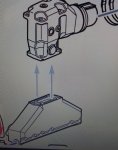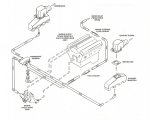Riggy
Well-Known Member
This has probably been asked before at some point but the myriad of Volvo Penta engine threads is mind boggling.
Previous owner said he had regular maintenance done but after owning this boat for a year and a half I am finding to my cost that he didn't and it's turning into an expensive Jonah boat. The raw water intakes/manifolds should be changed every 5/6 years and this boat is now over 10 years old so he obviously hadn't done essential maintenance.
The water had come from the left hand raw water intake/cooling system (which had corroded/disintegrated on the inside along with the gaskets, which led to the water ingress) which I (my mechanic) have now changed but my problem is, getting the water/oil mix of sludge out of a cold engine. We have tried pumping out through the oil dipstick tube but the sludge is stone cold and too thick.
Unfortunately it has taken nearly two months since the engine stopped running, to find and rectify the problem and renew the raw water intake, leaving gathering rust on the engine moving parts. Thus the bores have been dosed with WD40 through the spark plug holes and in a couple of days my excellent mechanic, with my help, will try turning the engine over by hand to try and release the piston rings from the bores gently (presuming they have gummed up with forming rust) before attempting a start. If we can start her up the sludge will be easy to drain when it is hot, with an electric pump but at this moment we/he are not too hopeful.
If anyone has any info/suggestions/knowledge about this situation I would be grateful.
Previous owner said he had regular maintenance done but after owning this boat for a year and a half I am finding to my cost that he didn't and it's turning into an expensive Jonah boat. The raw water intakes/manifolds should be changed every 5/6 years and this boat is now over 10 years old so he obviously hadn't done essential maintenance.
The water had come from the left hand raw water intake/cooling system (which had corroded/disintegrated on the inside along with the gaskets, which led to the water ingress) which I (my mechanic) have now changed but my problem is, getting the water/oil mix of sludge out of a cold engine. We have tried pumping out through the oil dipstick tube but the sludge is stone cold and too thick.
Unfortunately it has taken nearly two months since the engine stopped running, to find and rectify the problem and renew the raw water intake, leaving gathering rust on the engine moving parts. Thus the bores have been dosed with WD40 through the spark plug holes and in a couple of days my excellent mechanic, with my help, will try turning the engine over by hand to try and release the piston rings from the bores gently (presuming they have gummed up with forming rust) before attempting a start. If we can start her up the sludge will be easy to drain when it is hot, with an electric pump but at this moment we/he are not too hopeful.
If anyone has any info/suggestions/knowledge about this situation I would be grateful.


